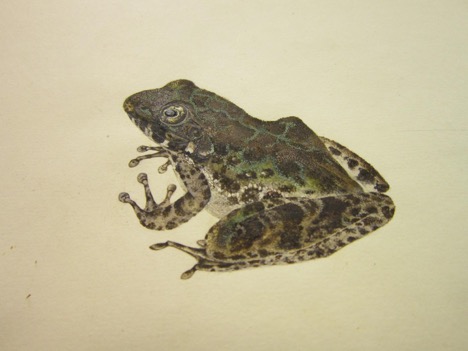
Wang Hao-t’ing (using the Chinese naming order with family name first) was a Chinese artist who was commissioned to accompany the American Museum of Natural History’s (AMNH) Third Asiatic Expedition in 1921-1926 to document frogs, snakes, salamanders, and lizards in the region. Hao-t’ing painted beautiful, strikingly realistic watercolor paintings of the herpetofauna.1
Wang began his training as an artist at age seventeen, with a teacher who trained him every day for nine years. Part of his traditional Chinese training had been to memorize famous architectural achievements and to paint them at a moment’s notice.2
When members of the AMNH arrived in China, they sought a local artist willing to travel great distances who could paint realistic images of the animals they came across. Wang immediately volunteered for the position, willing to go anywhere and do his best to paint with the accuracy scientific illustrations called for.
From Skilled Chinese Artist To Scientific Illustrator
On September 8, 1921, he made his first field trip with herpetologist Dr. Clifford Pope to record the colors of living animals in the field.1 Although he was already skilled in the technique of Chinese art, this was his introduction to the detailed and accurate methods of scientific illustration. According to Dr. Pope, Wang held up to four paint brushes simultaneously and was able to shift between them without moving anything but his fingers (see the video below to view Wang using this technique). This technique was common in Chinese landscape painting, the field in which Wang had been trained, however it was not commonly applied to scientific illustration at the time. In his account of Wang, Dr. Pope also described the importance of each paint brush itself, “When it came to selecting brushes, he took no end of pains and counted the number of hairs forming the extreme tip of each before buying.”2
A Journey of Discovery
The expedition’s sought to secure a large collection of the common Yangtze valley reptiles and amphibians; contrary to popular belief that collectors only sought rare or new species, they wanted a good series of common forms as well.1
While on expedition, Wang often worked in cramped and difficult conditions.2 On one leg of the journey, he painted frogs while hunched on the floor of a houseboat as the boat rocked and workmen scrubbed the deck, occasionally soaking his paintings by accident. In spite of this, Wang was described by Dr. Pope as cheerful and optimistic. Despite a language barrier, the men developed a friendship and productive working relationship, learning to supplement their limited dialogue with gestures and drawings. Wang developed an interest and excitement for discovering herpetofauna, and was particularly focused on finding the “two-headed snake” (which in actuality they discovered has a tail mimicking a head) and the elusive “red-bellied frog.”2 He also seemed to care for the animals he painted, and in multiple instances showed great distress when a specimen appeared sick or dying.
Learning to paint reptiles and amphibians presented a steep learning curve for Wang; however, after diligent practice there was no creature he could not accurately paint. He excelled at this new form of art and even developed innovative ways of depicting unusual specimens, such as translucent fish. Wang was an integral member of a team that ultimately documented many species in a region that was previously unexplored by zoologists.
Authored By: Melina Giakoumis and Amanda Sigouin
Wang Hao-t’ing’s Illustrations
References
- Andrews, R. C. The New Conquest of Central Asia: a Narrative of the Explorations of the Central Asiatic Expeditions in Mongolia and China, 1921-1930. New York: The American Museum of Natural History, 1932. Biodiversity Heritage Library. Web. https://www.biodiversitylibrary.org/item/45094#page/10/mode/1up
- Pope, Clifford Hillhouse. “Artist Wang.” China’s Animal Frontier. Viking Press, New York, 1940. pp. 100-111
Image Credits
- All images: Clifford H. Pope Collection, Department of Herpetology Archives, American Museum of Natural History.
- Video: The Central Asiatic Expeditions: Fauna, Film 146; American Museum of Natural History Research Library.
